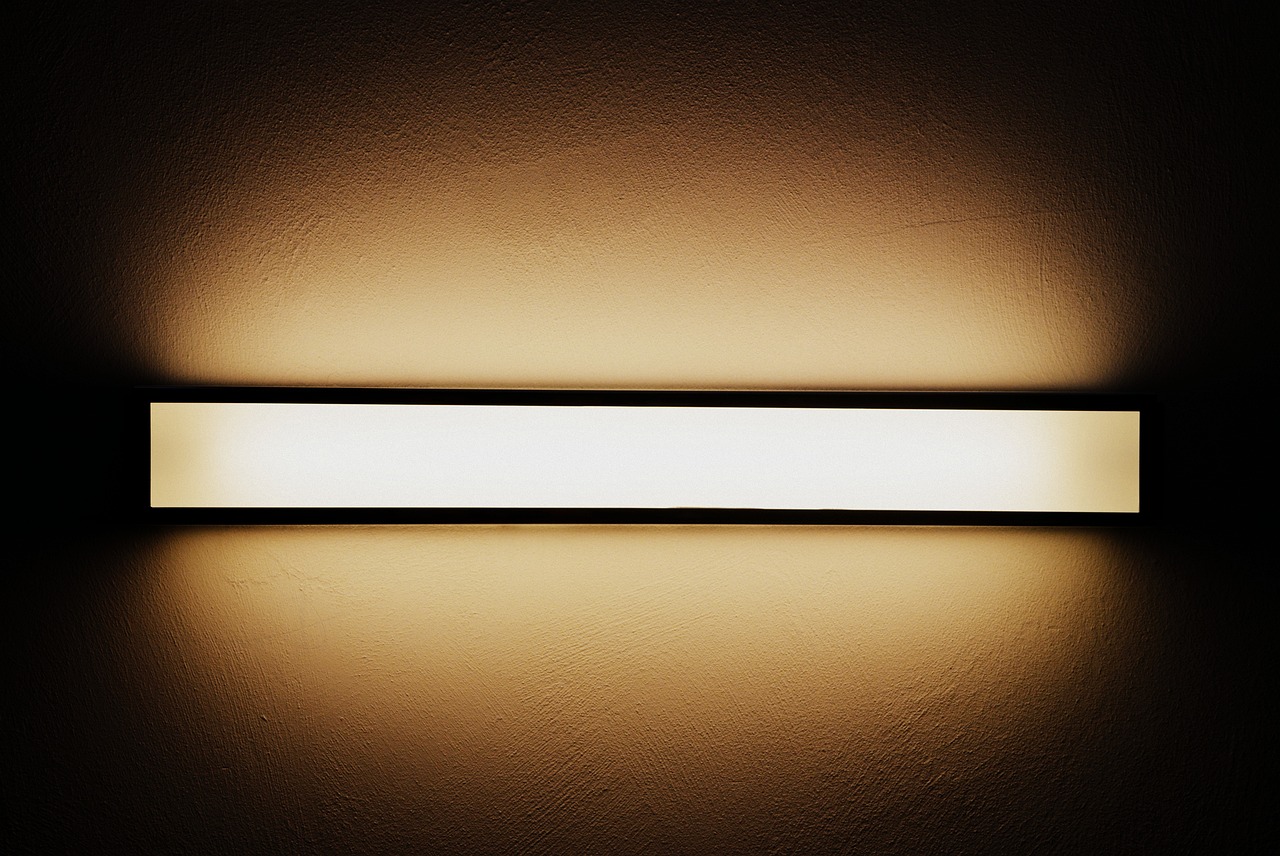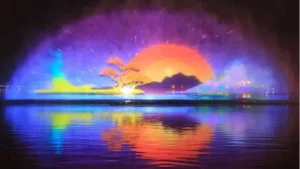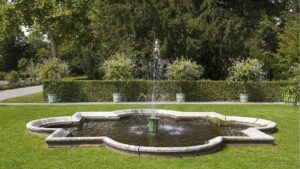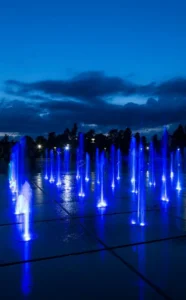- Product Knowledge
Uplighting vs Downlighting: Illuminating Your Space Perfectly
Lighting plays a crucial role in defining the ambiance, functionality, and aesthetics of any space. Whether you’re designing the interior of your home, planning an outdoor landscape, or setting up for a special event, understanding the differences between uplighting and downlighting can help you achieve the desired effect. This article explores the unique characteristics, benefits, and best applications of both uplighting and downlighting.
Definition of Uplighting
Uplighting involves placing light fixtures at or near the ground and directing the light upwards. This technique is commonly used to highlight architectural features, trees, and sculptures, creating dramatic and eye-catching effects. Uplighting can transform mundane objects and spaces into visually stunning elements by casting interesting shadows and emphasizing textures.

Definition of Downlighting
Downlighting, on the other hand, involves placing light fixtures above an area and directing the light downwards. This technique is often used for general illumination, task lighting, and enhancing safety and security. Downlighting provides a more natural and subtle lighting effect, mimicking the way sunlight illuminates spaces from above.
Importance of Lighting Choices
Choosing the right lighting technique is essential for creating the desired atmosphere and functionality in a space. Both uplighting and downlighting have their unique advantages and can be used to complement each other in various settings. Understanding their differences can help you make informed decisions that enhance the overall appeal and usability of your space.
Key Differences Between Uplighting and Downlighting
While both uplighting and downlighting are effective lighting techniques, they differ in several key aspects.
Direction of Light
The primary difference between uplighting and downlighting lies in the direction of the light. Uplighting directs light upwards, illuminating objects from below, while downlighting directs light downwards, illuminating areas from above. This fundamental difference affects the way shadows and highlights are cast, influencing the overall visual impact.
Visual Effects
Uplighting tends to create more dramatic and theatrical effects, highlighting the vertical lines and textures of objects. It can make spaces feel more dynamic and visually interesting. Downlighting, on the other hand, provides more even and functional illumination, creating a more natural and subdued ambiance.
Installation Methods
The installation methods for uplighting and downlighting also differ. Uplighting typically involves ground-mounted fixtures, such as spotlights and well lights, while downlighting often uses ceiling-mounted or overhead fixtures, such as recessed lights and pendant lights. The choice of fixtures and their placement can significantly impact the effectiveness of each technique.
Benefits of Uplighting
Uplighting offers several benefits that make it a popular choice for both indoor and outdoor lighting.
Enhancing Architectural Features
One of the primary uses of uplighting is to accentuate architectural features. By placing lights at the base of columns, walls, and other structures, uplighting can highlight the intricate details and textures, adding depth and dimension to the architecture.
Creating Dramatic Effects
Uplighting is ideal for creating dramatic lighting effects. The upward-directed light can cast striking shadows and illuminate objects in a way that draws attention and creates visual interest. This makes it a popular choice for events, stage lighting, and artistic displays.
Highlighting Landscaping
In outdoor settings, uplighting is commonly used to highlight landscaping features such as trees, shrubs, and statues. By illuminating these elements from below, uplighting can create a sense of depth and enhance the natural beauty of the landscape, making it more inviting and enchanting.
Benefits of Downlighting
Downlighting also offers several advantages that make it a versatile and practical lighting option.
Providing Functional Illumination
Downlighting is highly effective for providing functional illumination. It is commonly used in kitchens, bathrooms, and workspaces to provide bright, focused light for tasks. This type of lighting ensures that areas are well-lit, reducing the risk of accidents and improving visibility.
Enhancing Safety and Security
In both indoor and outdoor settings, downlighting can enhance safety and security. By illuminating pathways, entrances, and dark corners, downlighting can deter intruders and make spaces safer to navigate. It is often used in outdoor lighting designs to ensure that areas are well-lit and secure.
Creating Subtle Ambiance
Downlighting can create a subtle and cozy ambiance. It provides even illumination that mimics natural light, making spaces feel warm and inviting. This makes it a popular choice for living rooms, bedrooms, and dining areas where a relaxed and comfortable atmosphere is desired.
Best Applications for Uplighting
Uplighting is a versatile technique that can be used in a variety of settings to enhance the visual appeal of a space.
Indoor Applications
Indoors, uplighting can be used to highlight architectural features such as fireplaces, bookcases, and artwork. It can also be used to create accent lighting in living rooms, dining rooms, and entryways, adding a touch of elegance and sophistication.
Outdoor Applications
In outdoor settings, uplighting is perfect for highlighting trees, shrubs, and garden features. It can also be used to illuminate the exterior of buildings, creating a dramatic and inviting appearance. Pathways, driveways, and patios can also benefit from the enchanting effects of uplighting.
Event and Wedding Lighting
Uplighting is a popular choice for events and weddings. It can transform venues by creating a magical and romantic atmosphere. By strategically placing uplights around the venue, event planners can highlight key areas and create stunning visual effects that leave a lasting impression.
Best Applications for Downlighting
Downlighting is a practical and versatile lighting technique suitable for a wide range of applications.
Indoor Applications
Indoors, downlighting is commonly used for general illumination in kitchens, bathrooms, and hallways. It is also used for task lighting in areas where focused light is needed, such as reading nooks, workspaces, and study areas.
Outdoor Applications
In outdoor settings, downlighting is used to illuminate pathways, driveways, and entrances. It can also be used to highlight landscaping features and create a subtle, inviting ambiance for outdoor living spaces such as patios and decks.
Commercial and Industrial Lighting
Downlighting is widely used in commercial and industrial settings. It provides bright, even illumination that is essential for workspaces, retail stores, and warehouses. The focused light from downlighting ensures that areas are well-lit and safe, improving productivity and visibility.
Choosing the Right Lighting for Your Space
Selecting the right lighting for your space involves considering several factors to achieve the desired effect and functionality.
Assessing Your Needs
Start by assessing your lighting needs. Consider the purpose of the lighting, the activities that will take place in the space, and the mood you want to create. This will help you determine whether uplighting, downlighting, or a combination of both is best suited for your needs.
Considering the Environment
Take into account the environment where the lighting will be installed. Consider factors such as the size of the space, the existing decor, and the architectural features. This will help you choose lighting that complements the environment and enhances its overall appeal.
Balancing Aesthetic and Functional Requirements
It’s important to balance aesthetic and functional requirements when choosing lighting. While uplighting can create dramatic visual effects, downlighting provides practical illumination. By combining both techniques, you can achieve a well-rounded lighting design that meets both aesthetic and functional needs.
Combining Uplighting and Downlighting
Combining uplighting and downlighting can create a layered lighting effect that enhances the visual interest and functionality of a space.
Creating Layered Lighting
Layered lighting involves using multiple lighting techniques to create depth and dimension. By combining uplighting and downlighting, you can highlight architectural features, provide functional illumination, and create a balanced and harmonious lighting design.
Enhancing Visual Interest
Using both uplighting and downlighting can enhance the visual interest of a space. The interplay of light and shadow can create dynamic and captivating effects, making the space more engaging and visually appealing.
Practical Tips for Combining Techniques
When combining uplighting and downlighting, consider the placement and intensity of each light source. Avoid overdoing the effects, as too much lighting can be overwhelming. Instead, aim for a balanced approach that highlights key areas while providing sufficient illumination.
Common Mistakes to Avoid with Uplighting and Downlighting
Avoiding common mistakes can help you achieve the best results with your lighting design.
Overdoing the Effects
One common mistake is overdoing the effects with too many lights or overly intense illumination. This can create an unbalanced and uncomfortable atmosphere. Instead, aim for a subtle and balanced approach that enhances the space without overwhelming it.
Ignoring Maintenance
Proper maintenance is essential for keeping your lighting fixtures in good condition. Ignoring maintenance can lead to reduced performance and shorter lifespan of your lights. Regularly clean and check your fixtures to ensure they continue to function properly.
Poor Placement Choices
The placement of your lighting fixtures is crucial for achieving the desired effect. Poor placement can result in uneven illumination and ineffective lighting. Take the time to plan the placement of your lights carefully, considering factors such as the direction of light, the height of fixtures, and the areas you want to highlight.
Choosing the right lighting technique for your space can significantly impact its overall ambiance and functionality. By understanding the differences between uplighting and downlighting, you can make informed decisions that enhance the beauty and usability of your environment. Whether you choose to use one technique or combine both, the right lighting can transform any space into a visually stunning and inviting haven.
Frequently Asked Questions
Uplighting directs light upwards to highlight objects from below, creating dramatic effects. Downlighting directs light downwards to provide functional illumination and create a more natural ambiance.
Yes, combining uplighting and downlighting can create a layered lighting effect that enhances both visual interest and functionality in a space.
Uplighting is often the best choice for highlighting landscaping features, such as trees and shrubs, as it creates dramatic and enchanting effects.
Uplighting can highlight architectural features, create accent lighting, and add a touch of elegance and sophistication to indoor spaces.
Yes, there are many energy-efficient options available, such as LED lights, which provide excellent illumination while consuming less energy and lasting longer.



